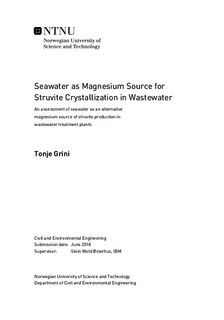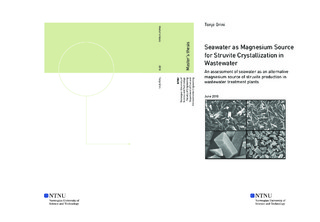| dc.description.abstract | Phosphorus (P) from wastewater and agricultural fertilizers are discharged to water bodies and contribute to eutrophication. At the same time, phosphate rock used for fertilizer production is a non-renewable resource that will be depleted during the next century. It is therefore crucial to remove and recycle phosphorus from discharge sources.
One method for recycling P from wastewater is to crystallize magnesium-ammonium-phosphate (MAP), also known as struvite. Struvite is a suitable slow-release fertilizer that can replace phosphate from mining. For efficient production in wastewater treatment plants we need to add a magnesium (Mg) source. Today, mainly pure Mg salts (e.g. magnesium chloride, MgCl2) are used for this purpose, but cheaper and more sustainable alternatives have been proposed. One of them is seawater, which can be used by wastewater utilities located near the coast. Possible side-effects of using seawater are the interference of seawater constituents on struvite precipitation, and that the dilution from seawater addition will impact P removal efficiency compared to pure Mg sources.
In this study, laboratory-scale experiments, thermodynamic equilibrium calculations and cost estimations were conducted in order to assess the performance of seawater for struvite crystallization. The main objectives were:
o To study the effect of seawater constituents and dilution on P recovery and product characteristics when using seawater as Mg source for struvite precipitation.
o To estimate how much operating costs of struvite production can be reduced by using seawater instead of a pure Mg salt.
The results show that the impact of seawater constituents on P recovery is more apparent at lower supersaturation values of struvite (low pH). Although dilution of the wastewater stream from seawater addition is lowering the supersaturation compared to the pure Mg source, a P recovery of >90% was achieved at pH 8.0 and Mg:P molar ratio ≥1.67. P recovery and solids analysis showed that co-precipitation might have occurred, although to a very little extent. Laboratory experiments and thermodynamic equilibrium calculations showed that seawater can be considered as a good alternative to magnesium chemicals in struvite production, and cost estimations showed a potential cost reduction of ∼20%. | |

